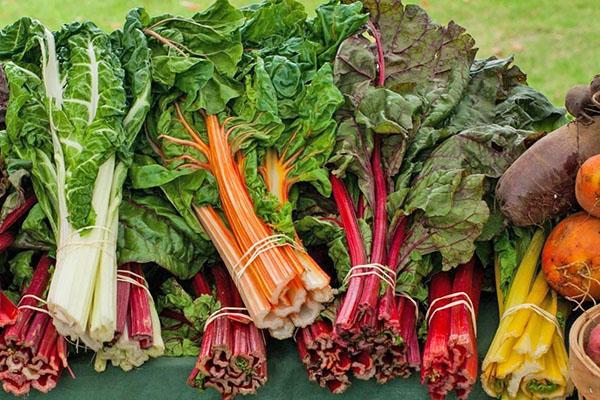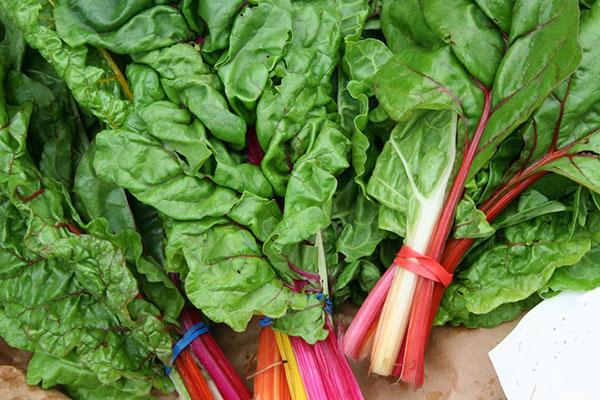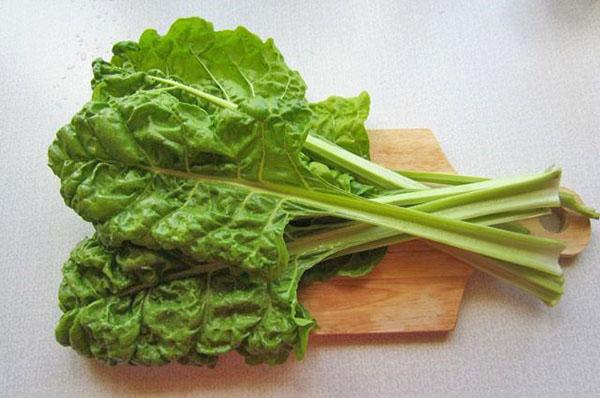Growing and caring for chard in summer cottages

Chard, or leaf beet, is a close relative of sugar beet, feed beet and regular salad beet. Growing and caring for Swiss chard is not difficult. Although this plant is two years old and belongs to the amaranth family, it is still grown as an annual. If you take good care of the wintering of such beets, they can easily overwinter in a greenhouse or in a garden bed. And starting from April it will delight you with fresh herbs. The greens of the plant are not only pleasant to the taste, but also rich in protein compounds, vitamins, sugar, iron, phosphorus and calcium.
Because of its taste and healthiness, the French often use Swiss chard as a substitute for spinach and asparagus.
Beetroot varieties

Chard varieties can be distinguished by stem color and leaf type, which are of great nutritional value. Some decorative varieties of deciduous beets are planted in flower beds due to the combination of rich colors.
The most common varieties:
- Stem or veined chard, in other words, herbal stem. Widespread in Switzerland. It is easy to distinguish from other varieties due to noticeable streaks of white and red color. Red-veined deciduous beets have a more pronounced odor. In spring, chard sprouts emerge earlier than all other early plants.
- The second, no less well-known variety of deciduous beets is chives-chard, aka Roman cabbage. After cutting off the leaves, the plant almost instantly starts up new ones that can be used for food purposes. This plant variety is more cold-tolerant than the herbal stem.

Where and when to plant

The plant prefers fertile soil rich in N and K elements. Otherwise, the plant becomes tough and unsuitable for human consumption. Mangold loves light, but also takes root well in light partial shade. When chard is grown in the shade, its leaves become especially tender and juicy, but all this at the expense of the severity of the variegated color.
It is not recommended to plant Swiss chard to compact tomatoes in a greenhouse. This is due to different watering requirements. Tomatoes require occasional abundant watering, while chard needs constant moisture. As neighbors, leaf beets are ideal cucumbers... It is advisable to grow chard outdoors.
Mangold is a cold-resistant plant. Seedlings will grow without problems at a temperature of 4 ° C, and the seedlings are able to survive frosts down to -6 ° C. However, it is not recommended to plant the plant very early in spring due to its rapid maturation with slow leaf development.
It is advisable to plant chard outdoors in mid to late April. If planted in late spring or summer, the yield will be much less.
Chard care

The process of growing and caring for chard does not require much effort. However, in order to achieve the suggested size of the leaves and their juiciness, you need to take time to care for the plant.
After one and a half to two weeks, the first shoots appear. After 5 ripe leaves appear on the plant, it is necessary to start thinning. Only one plant, the healthiest one, should be left in each bed. Removed plants can be planted elsewhere and the soil around them can be compacted.

Caring for deciduous beets includes:
- Regular moistening of the soil with water.
- Providing soil access to air by loosening the space between the rows.
- Fertilize plants from time to time.
It is better to water the beds and fertilize them simultaneously by mixing water with special feeding.
When growing and caring for chard, nitrogen-containing fertilizers can be used only in the early stages of plant life. The outer leaves must be cut off a little at a time, this contributes to an even greater growth of chard. The maximum cutting at a time is a quarter of the leaves. The plucked leaves must be wrapped in plastic and placed in the refrigerator, as they quickly die.
When cutting leaves, the growing point should never be touched.
Healthy plants are able to overwinter in the garden. But for this you need to cover them with earth, cover compost and foliage before frost. If the winter was without severe frosts, then most likely the plant will begin to grow in early spring.
Harvesting

You can start harvesting within one and a half to two weeks after sowing. Throughout the entire time, it is necessary to cut off large and extreme leaves, regardless of whether they are needed at the moment or not. Otherwise, the leaves will lose their delicate taste and juiciness.
The plant grows until late autumn. In petiolate chard, the leaves can be pinched only after they are fully ripe. The remaining crop can be frozen by first pouring boiling water over it.
Pests and diseases

Chard is quite resistant to all kinds of insects and diseases. However, sometimes viral diseases can kill the plant. The most dangerous pests for leaf beets are slugs. There is also a risk of fungal diseases in the absence of timely thinning of seedlings.
Prevention is important in this matter. In order to avoid various diseases and pests, you need to properly care for the plant.
Growing and caring for chard on a windowsill

To grow chard on a windowsill or balcony, you must first prepare the roots from the autumn garden. Specimens with thick absorbent roots are best suited for growing at home.
When growing chard seedlings, the roots are planted at a distance of 1-2 cm from each other and then slightly covered with a mixture of humus, sand and turf. All components are mixed in equal proportions. When falling asleep, leave a small hole for growth.
The seedlings should stand for one to two weeks at a temperature of 7 to 10 ° C. After a week of germination of chard at a temperature of 7-10 ° C, it must be placed in a warmer place, and it will begin to grow many times faster. The most suitable temperature is 18-21 ° C. It is advisable to place the plant in a place with sufficient sun and no drafts.
Watering home chard is necessary as the soil dries up with water at room temperature. It is also desirable to feed the plant with organo-mineral fertilizing at a frequency of 2 times a month.
Where is used

Mangold is rich in vitamins and tastes quite good. In addition, deciduous beets sprout quickly, thrive and yield a lot. But where to use it?
In cooking

Beetroot is widely used in various dishes in many countries. Only young leaves will do. With proper care, they will have tenderness and juiciness.
Deciduous beets are actively used in the preparation of balanced food on a dietary diet, in the preparation of vinaigrettes, stuffed cabbage, soups and borscht. Stewed deciduous beet is used as an appetizer for noodles and a garnish for meat. Chard is often stewed in butter and lard, like spinach. Casting chard can be fermented with or separately from cabbage. The petioles can be closed for the winter like cucumbers. The plant is also used as a decoration for dishes. Deciduous beets can easily replace lettuce leaves without sacrificing taste.
In medicine

Beetroot has several medicinal properties.For example, doctors often advise using it for diabetes, anemia, kidney stones, high blood pressure. Also Swiss chard is able to support the immune system. Grated chard root is an effective way to combat hair loss.